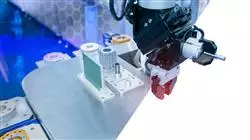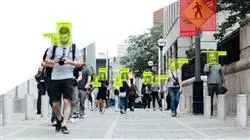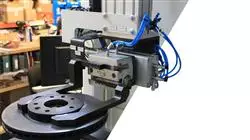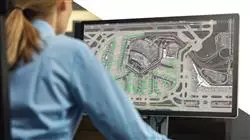University certificate
The world's largest faculty of information technology”
Introduction to the Program
Computer Vision is the most demanded field within artificial intelligence and Machine Learning. Don't wait any longer and take advantage of the opportunity to access the latest knowledge in this sector"

Artificial intelligence and associated sectors such as Machine Learning have been the most important areas of the technology industry for only a few years. Therefore, more and more programs and machines are being developed that are capable of learning to perform complex tasks in order to improve existing services. It is therefore not just a matter of automating the performance of tasks, but of being able to go further. Computer Vision achieves that goal and offers great solutions to contemporary and future technological challenges.
Computer Vision gives robots and machines the ability to process the spatial environment and capture images systematically, obtaining interesting data that can be used in different fields. For this reason, it is such a powerful tool that most technology companies are trying to develop projects in this direction. As such, this Postgraduate diploma allows the computer scientists to delve into the latest developments in this complex and promising area, so that at the end of the program they will have delved into issues such as visible and non-visible frequencies, digital image composition and image indexing and digital processing, among many others.
In order to enjoy an optimal learning process, TECH Global University has designed a 100% online teaching methodology that guarantees that computer scientists are able to balance their studies with their professional career without any interruptions. All of this is accompanied by a prestigious teaching staff and high-level multimedia teaching materials such as interactive summaries, practical activities and master classes.
Learn about the latest innovations in Computer Vision and Machine Learning thanks to this Postgraduate diploma"
This Postgraduate diploma in Computer Vision contains the most complete and up-to-date educational program on the market. Its most notable features are:
- The development of case studies presented by experts in computer science and Computer Vision
- The graphic, schematic, and practical contents with which they are created, provide scientific and practical information on the disciplines that are essential for professional practice
- Practical exercises where the self-assessment process can be carried out to improve learning
- Its special emphasis on innovative methodologies
- Theoretical lessons, questions to the expert, debate forums on controversial topics, and individual reflection assignments
- Content that is accessible from any fixed or portable device with an Internet connection
Computer Vision is a promising discipline and if you specialize in it, you will become a highly sought-after professional by the major technology companies of the moment"
The program’s teaching staff includes professionals from sector who contribute their work experience to this program, as well as renowned specialists from leading societies and prestigious universities.
The multimedia content, developed with the latest educational technology, will provide the professional with situated and contextual learning, i.e., a simulated environment that will provide immersive education programmed to learn in real situations.
This program is designed around Problem-Based Learning, whereby the professional must try to solve the different professional practice situations that arise during the academic year. For this purpose, the student will be assisted by an innovative interactive video system created by renowned and experienced experts.
Apply the most innovative Computer Vision techniques to your artificial intelligence projects in a simple and effective way"

Computer Vision is the technology of the present and the future. Enroll and achieve all your professional goals"
Syllabus
This Postgraduate diploma in Computer Vision is made up of 3 specialized modules that will enable the computer scientist to learn about the latest developments in aspects such as the applications of this technology, hyperspectral and multispectral cameras, Computer Vision libraries, masks and convolution or image calibration, among many others. At the end of the program, the professional will have acquired in-depth and up-to-date knowledge on this subject.

Deepen in the applications of Computer Vision with this Postgraduate diploma"
Module 1. Computer Vision
1.1. Human Perception
1.1.1. Human Visual System
1.1.2. Color
1.1.3. Visible and Non-Visible Frequencies
1.2. Summary of Computer Vision
1.2.1. Principles
1.2.2. Evolution
1.2.3. The Importance of Computer Vision
1.3. Digital Image Composition
1.3.1. The Digital Image
1.3.2. Types of Images
1.3.3. Color Spaces
1.3.4. RGB
1.3.5. HSV and HSL
1.3.6. CMY-CMYK
1.3.7. YCbCr
1.3.8. Indexed Image
1.4. Image Acquisition Systems
1.4.1. Operation of a Digital Camera
1.4.2. The Correct Exposure for Each Situation
1.4.3. Depth of Field
1.4.4. Resolution
1.4.5. Image Formats
1.4.6. HDR Mode
1.4.7. High Resolution Cameras
1.4.8. High-Speed Cameras
1.5. Optical Systems
1.5.1. Optical Principles
1.5.2. Conventional Lenses
1.5.3. Telecentric Lenses
1.5.4. Types of Autofocus Lenses
1.5.5. Focal Length
1.5.6. Depth of Field
1.5.7. Optical Distortion
1.5.8. Calibration of an Image
1.6. Illumination Systems
1.6.1. Importance of Illumination
1.6.2. Frequency Response
1.6.3. LED Illumination
1.6.4. Outdoor Lighting
1.6.5. Types of Lighting for Industrial Applications. Effects
1.7. 3D Acquisition Systems
1.7.1. Stereo Vision
1.7.2. Triangulation
1.7.3. Structured Light
1.7.4. Time of Flight
1.7.5. Lidar
1.8. Multispectrum
1.8.1. Multispectral Cameras
1.8.2. Hyperspectral Cameras
1.9. Non-Visible Near Spectrum
1.9.1. IR Cameras
1.9.2. UV Cameras
1.9.3. Converting From Non-Visible to Visible by Illumination
1.10. Other Band Spectrums
1.10.1. X-Ray
1.10.2. Terahertz
Module 2. Applications and State-of-the-Art
2.1. Industrial Applications
2.1.1. Machine Vision Libraries
2.1.2. Compact Cameras
2.1.3. PC-Based Systems
2.1.4. Industrial Robotics
2.1.5. Pick and Place 2D
2.1.6. Bin Picking
2.1.7. Quality Control
2.1.8. Presence Absence of Components
2.1.9. Dimensional Control
2.1.10. Labeling Control
2.1.11. Traceability
2.2. Autonomous Vehicles
2.2.1. Driver Assistance
2.2.2. Autonomous Driving
2.3. Computer Vision for Content Analysis
2.3.1. Filtering by Content
2.3.2. Visual Content Moderation
2.3.3. Tracking Systems
2.3.4. Brand and Logo Identification
2.3.5. Video Labeling and Classification
2.3.6. Scene Change Detection
2.3.7. Text or Credits Extraction
2.4. Medical Application
2.4.1. Disease Detection and Localization
2.4.2. Cancer and X-Ray Analysis
2.4.3. Advances in Computer Vision Due to Covid-19
2.4.4. Assistance in the Operating Room
2.5. Spatial Applications
2.5.1. Satellite Image Analysis
2.5.2. Computer Vision for the Study of Space
2.5.3. Mission to Mars
2.6. Commercial Applications
2.6.1. Stock Control
2.6.2. Video Surveillance, Home Security
2.6.3. Parking Cameras
2.6.4. Population Control Cameras
2.6.5. Speed Cameras
2.7. Vision Applied to Robotics
2.7.1. Drones
2.7.2. AGV
2.7.3. Vision in Collaborative Robots
2.7.4. The Eyes of the Robots
2.8. Augmented Reality
2.8.1. Operation
2.8.2. Devices
2.8.3. Applications in the Industry
2.8.4. Commercial Applications
2.9. Cloud Computing
2.9.1. Cloud Computing Platforms
2.9.2. From Cloud Computing to Production
2.10. Research and State-of-the-Art
2.10.1. Commercial Applications
2.10.2. What's Cooking?
2.10.3. The Future of Computer Vision
Module 3. Digital Image Processing
3.1. Computer Vision Development Environment
3.1.1. Computer Vision Libraries
3.1.2. Programming Environment
3.1.3. Visualization Tools
3.2. Digital image Processing
3.2.1. Pixel Relationships
3.2.2. Image Operations
3.2.3. Geometric Transformations
3.3. Pixel Operations
3.3.1. Histogram
3.3.2. Histogram Transformations
3.3.3. Operations on Color Images
3.4. Logical and Arithmetic Operations
3.4.1. Addition and Subtraction
3.4.2. Product and Division
3.4.3. And/Nand
3.4.4. Or/Nor
3.4.5. Xor/Xnor
3.5. Filters
3.5.1. Masks and Convolution
3.5.2. Linear Filtering
3.5.3. Non-Linear Filtering
3.5.4. Fourier Analysis
3.6. Morphological Operations
3.6.1. Erosion and Dilation
3.6.2. Closing and Opening
3.6.3. Top Hat and Black Hat
3.6.4. Contour Detection
3.6.5. Skeleton
3.6.6. Hole Filling
3.6.7. Convex Hull
3.7. Image Analysis Tools
3.7.1. Edge Detection
3.7.2. Detection of Blobs
3.7.3. Dimensional Control
3.7.4. Color Inspection
3.8. Object Segmentation
3.8.1. Image Segmentation
3.8.2. Classical Segmentation Techniques
3.8.3. Real Applications
3.9. Image Calibration
3.9.1. Image Calibration
3.9.2. Methods of Calibration
3.9.3. Calibration Process in a 2D Camera/Robot System
3.10. Image Processing in a Real Environment
3.10.1. Problem Analysis
3.10.2. Image Processing
3.10.3. Feature Extraction
3.10.4. Final Results

You will have access to the best contents in Computer Vision, from the best professors in the field"
Postgraduate Diploma in Computer Vision
.
Machine vision is an ever-growing discipline that combines artificial intelligence and image processing to develop systems capable of interpreting and understanding the visual environment in a manner similar to humans. As a computer vision expert, you will have the ability to design and develop innovative solutions in fields as diverse as robotics, medicine, security, industry and many others. Prepare yourself to excel in this constantly evolving area with TECH Global University's Postgraduate Diploma in Computer Vision. This program will provide you with the knowledge and skills necessary to understand the theoretical foundations and practical techniques of machine vision. Through a combination of theory and practice, you will learn to use specialized algorithms and tools for image processing and visual information extraction. This course is taught completely online, allowing you to study at your own pace and from anywhere. You will be supported by experienced professionals in the field of computer vision, who will guide you through your learning and provide you with the tools you need to address practical challenges and apply innovative solutions. Throughout the program, you will explore topics such as image processing, object detection and tracking, image segmentation, pattern recognition, 3D vision and computer vision. In addition, you will learn how to use popular libraries and frameworks in the field of computer vision, such as OpenCV and TensorFlow.
Specialize in virtual mode in Computer Vision
.
This program is aimed at professionals and students in engineering, computer science, mathematics and related fields who wish to specialize in the area of machine vision. It is also suitable for those working in industries that require image analysis and visual interpretation, such as industrial automation, medicine, robotics, security, and visual data analysis.







